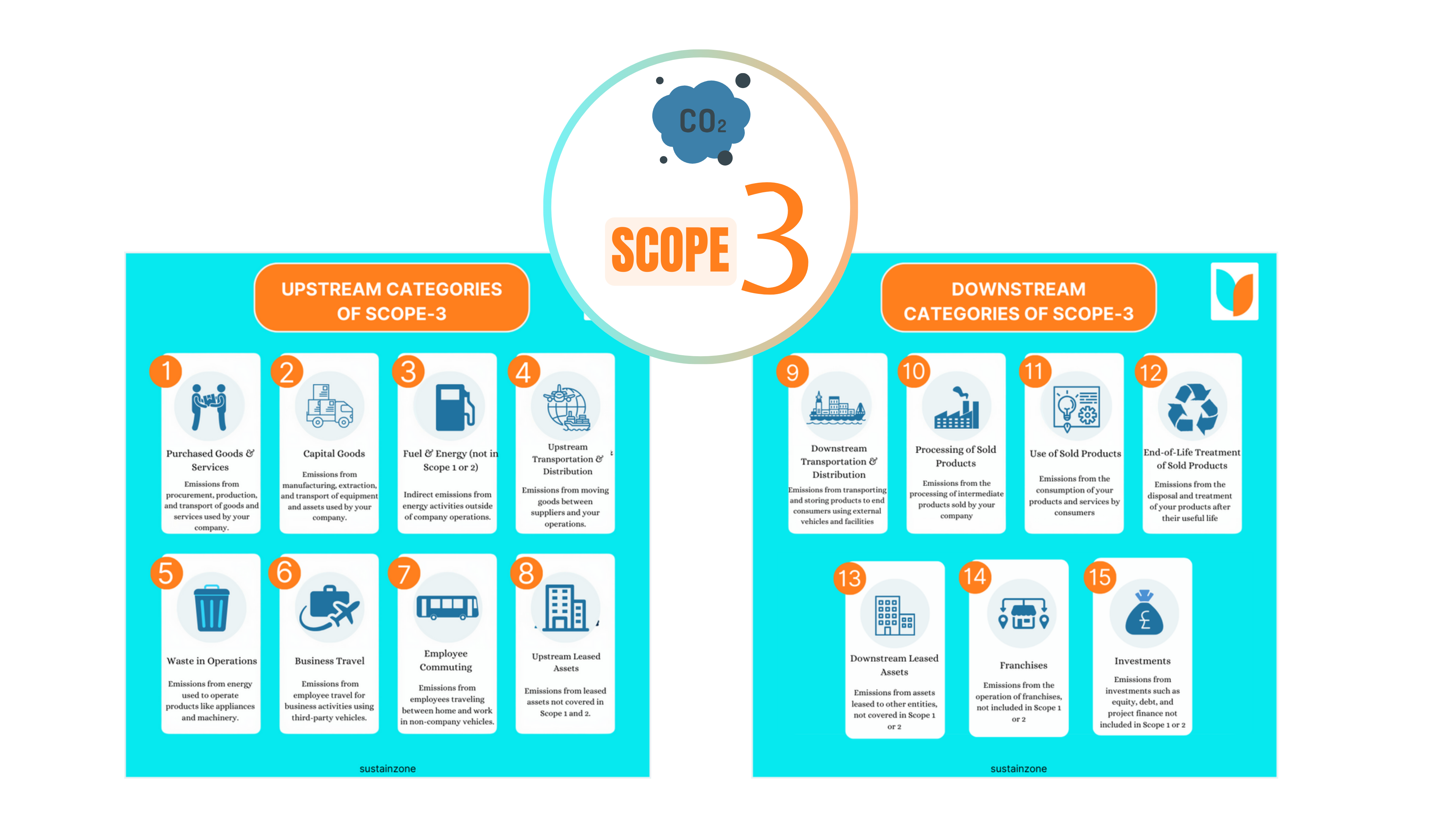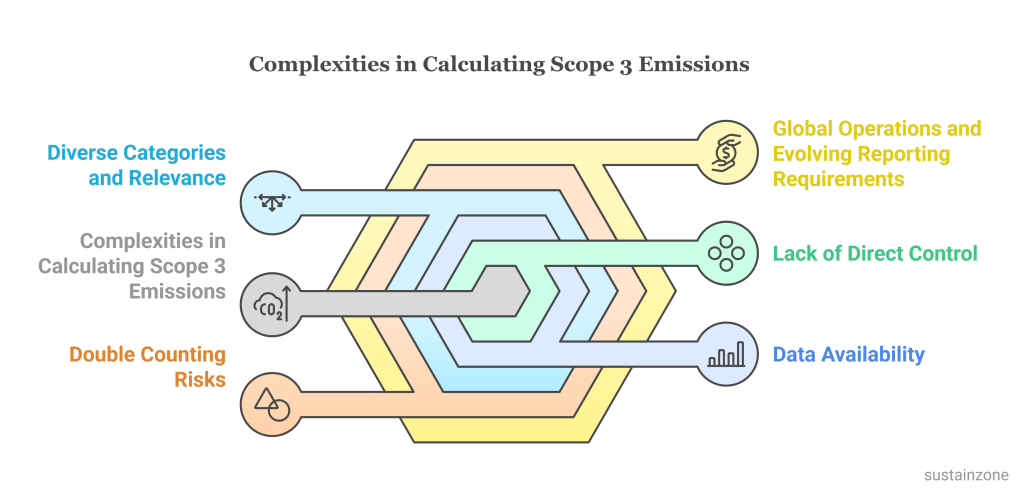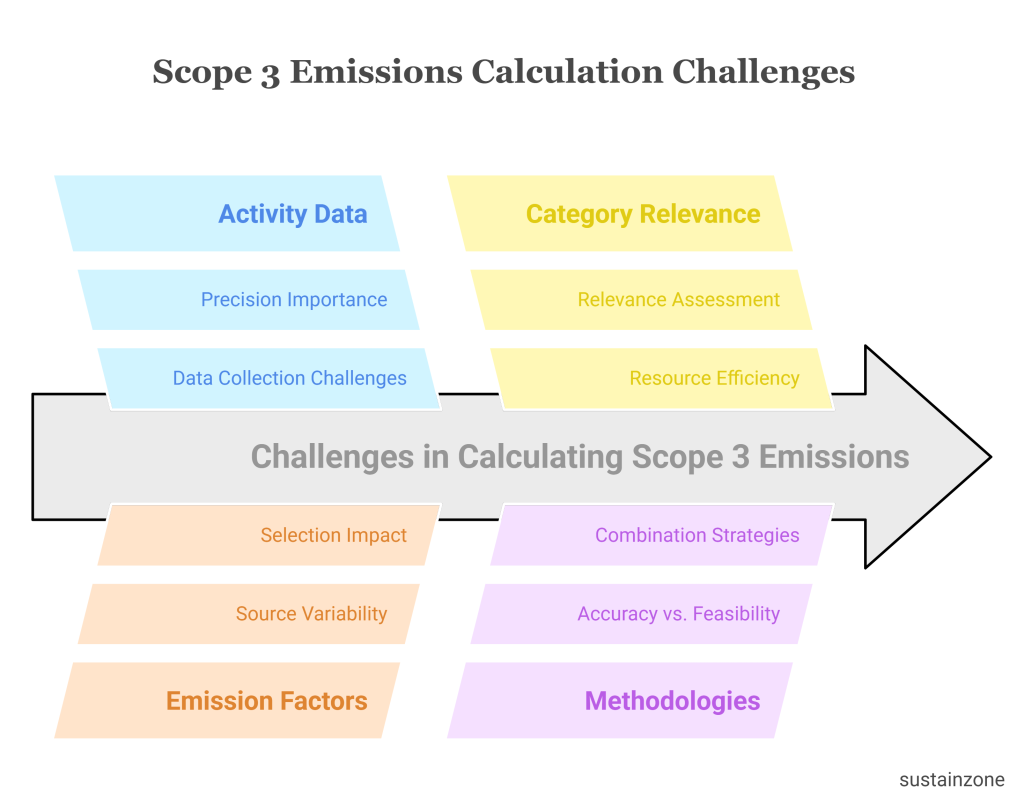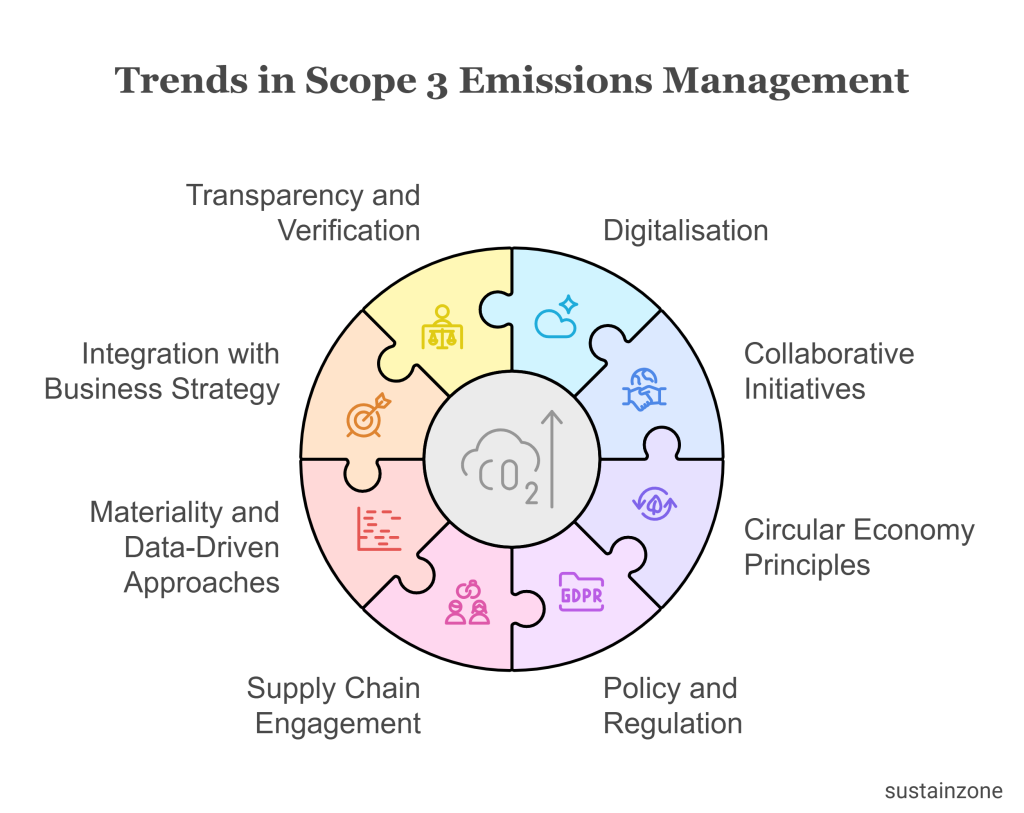Introduction: The Invisible Carbon Footprint
Imagine this: You’re at a supermarket, picking up a loaf of bread. While you consider the price, the ingredients, and even the packaging, what you can’t see is the carbon footprint of that bread. From the fertilisers used on the wheat fields to the trucks that transported it to the store, the environmental cost of this single product extends far beyond its shelf. These unseen emissions, often dwarfed by direct emissions from factories and offices, are what we call Scope 3 emissions. For businesses, understanding and addressing Scope 3 emissions isn’t just a regulatory requirement; it’s a step toward genuine sustainability.
Understanding Scope 3 Emissions
Scope 3 emissions encompass all indirect greenhouse gas (GHG) emissions resulting from a company’s value chain. These include upstream activities like supplier emissions and downstream activities such as the use and disposal of solid products. Unlike Scope 1 and 2 emissions, which are relatively straightforward to measure and manage, Scope 3 often accounts for the majority of an organisation’s total emissions. Categories under Scope 3 can range from purchased goods and services to employee commuting and even the end-of-life treatment of products.

Complexities in Calculating Scope 3 Emissions
Calculating Scope 3 emissions is like piecing together a puzzle without having all the pieces. The complexities arise due to:
1. Lack of Direct Control:
Scope 3 emissions occur outside a company’s direct control, making it hard to reduce them directly. It requires influencing the activities of value chain partners.
2. Data Availability:
Gathering accurate and comprehensive data across the entire value chain is a major hurdle. Companies often struggle to get reliable information from their suppliers, customers, and other value chain partners. Different methods like inspecting invoices, conducting surveys, and using estimations need to be used, depending on the availability of paper trail data. The most accurate method is to collect primary data directly from suppliers, but this is time-consuming, and not all suppliers have this information available.
3. Diverse Categories and Relevance:
The Greenhouse Gas Protocol (GHG Protocol) defines 15 distinct categories of Scope 3 emissions. These cover a wide range of activities both upstream and downstream of a company’s operations, such as purchased goods and services, capital goods, transportation, waste, business travel, leased assets and investments. Some categories require complex modelling and assumptions, like purchased goods and services and end-of-life treatment of sold products. Upstream emissions come from the production of a business’s products or services, while downstream emissions come from their use and disposal. This distinction adds complexity in the calculation.
4. Double Counting Risks:
Although the Scope 3 Standard is designed to prevent double counting, some companies, especially those involved in multiple stages of a product lifecycle, might face overlaps in reporting boundaries. Collaborating with value chain partners requires ensuring emissions are not reported multiple times. To avoid misinterpretation of data, companies need to be transparent and report these overlaps.
5. Global Operations:
Regional Data Variations- Multinational companies operating in different regions often face inconsistencies in data collection and reporting standards. This can complicate consolidating data into a single, comprehensive Scope 3 inventory.
6. Evolving Reporting Requirements:
Scope 3 reporting is becoming more regulated, necessitating that companies adapt to changing requirements. Companies must develop the capabilities to collect, manage, and report value chain emissions.
7. Hybrid calculation approach:
Companies may need to use a combination of methods for various scope 3 categories or activities within a category. For example, a hybrid method uses supplier-specific and activity-based data when available, and fills in gaps with industry averages.

Metrics for Calculation
(what data and criteria are needed to measure Scope 3 emissions)
To effectively measure Scope 3 emissions, companies need to focus on key metrics that provide a clear understanding of their value chain’s environmental impact. These metrics involve collecting and analysing data to convert activities into greenhouse gas emissions, and they can be broadly categorised into activity data, emission factors, and category relevance:
1. Activity Data:
The quantitative information about a company’s operations and the activities within its value chain that generate emissions; for example- kilograms of raw material purchased or miles travelled by logistics partners.
•Data Collection: Activity data can be sourced from invoices, purchase orders, travel records, supplier surveys, and internal tracking systems.
•Importance: Accurate activity data is essential for calculating a company’s carbon footprint. The more specific the data, the more precise the emission calculations will be.
•Challenges: Obtaining detailed activity data can be difficult, particularly from tier 2 and 3 suppliers, or for downstream activities.
2. Emission Factors:
Conversion rates that translate activity data into GHG emissions. They express the amount of GHG emitted per unit of activity (e.g., kg of CO2e per kWh of electricity, or kg of CO2e per tonne of material).
•Sources of Emission Factors– Government Agencies, Industry Databases, Academic Research, Company Reports.
•Types of Emission Factors includes – Life Cycle Emission Factors, Combustion Emission Factors, Upstream Emission Factors, Spend-Based Emission Factors and so on.
•Importance: The selection of appropriate emission factors is crucial for accurate calculations. Different factors can lead to varying results for the same activity data.
•Challenges: There is no universal source of emission factors, so companies must source them from various places. Also, emission factors vary depending on the product, geographical location, technology used, and supply chain conditions.
3. Category Relevance:
Refers to identifying and prioritising the 15 Scope 3 categories based on their significance to a company’s specific operations and business goals. Not all categories will be equally relevant to every business.
•Relevance Assessment– The Scope 3 Standard provides criteria for assessing relevance, including size, influence, risk, stakeholders, outsourcing, and sector guidance. A materiality assessment helps to pinpoint the most relevant categories.
•Importance: Focusing on relevant categories prevents a company from being overwhelmed by data and allows for efficient use of resources.
By focusing on these metrics companies can develop a robust and insightful understanding of their Scope 3 emissions, allowing them to implement effective reduction strategies.

Methods for Calculation
Several methodologies are available to calculate Scope 3 emissions:
1. Spend-Based Method: Uses financial data and emission factors to estimate emissions. It is straightforward but less accurate.
2. Average-Data Method: This relies on sector-wide averages and is ideal for companies starting their reporting journey.
3. Supplier-Specific Method: Leverages data provided by individual suppliers, offering the highest accuracy but requiring substantial collaboration.
4. Hybrid Approaches: Combining spend-based and supplier-specific methods can strike a balance between accuracy and feasibility.
5. Phased Approach: It’s common for companies to start with less specific methods and then transition to more accurate ones, as they gain better data and resources. For example, a company may start with a spend-based method to get an overview of their emissions, then move to a hybrid approach to get more accurate data from their key suppliers.
6. Materiality: Companies should focus on the categories and activities that contribute the most to their overall carbon footprint and are most relevant to their business goals. This helps to ensure that efforts are focused on areas where they will have the most impact.
7. Combination of Methods: It is possible to use a combination of methods for different scope 3 categories. For example, a company may use a spend-based method for a low-impact category and a supplier-specific method for a high-impact category.
By understanding these methodologies, companies can make informed decisions about how to measure and reduce their Scope 3 emissions, aligning with global sustainability goals.
Technical Guidance
Navigating the technical aspects of Scope 3 emissions reporting requires adherence to frameworks like the GHG Protocol’s Scope 3 Standard. Key steps include:
Mapping the Value Chain:
This involves identifying and understanding all activities within a company’s upstream and downstream operations. A company’s value chain consists of all activities related to the production and distribution of goods and services, from the extraction of raw materials to the end-of-life treatment of products. Mapping the value chain is crucial for identifying emission hotspots, which are the areas of a company’s operations that produce the largest amount of greenhouse gas (GHG) emissions.
Engaging Suppliers:
Supplier engagement is critical for collecting accurate data on Scope 3 emissions. This involves collaborating with suppliers to improve data sharing, transparency, and accountability. Companies should work directly with vendors to collect data, ideally in digital formats. When collecting data from suppliers, the supplier-specific method is considered to provide the most accurate results.
Utilising Tools:
Several tools and resources can assist with Scope 3 emissions reporting. Various tools and resources are available to support Scope 3 emissions reporting. These platforms help companies track, calculate, and report their environmental impacts effectively. They provide guidance on emissions factors, life cycle assessments, and data collection. Additionally, automation software and third-party databases simplify the analysis of complex value chains, enabling businesses to identify emission hotspots and enhance their sustainability strategies.
Third-Party Verification:
Third-party verification is essential for ensuring the credibility and accuracy of Scope 3 emissions reporting. This process involves an independent audit of a company’s emissions data, calculations, and methodologies. Verification helps to ensure that the emissions data is reliable, consistent, and transparent. Companies may seek third-party verification for all, or a portion, of their Scope 3 emissions. Third party verification can help provide assurance to stakeholders.
Latest Trends in Scope 3 Emissions Management
Businesses worldwide are evolving their strategies for managing Scope 3 emissions, driven by regulatory shifts, technological innovations, and stakeholder demands. Key trends include:
1. Digitalisation:
Artificial intelligence (AI) and blockchain technologies are being increasingly adopted to enhance the efficiency and accuracy of Scope 3 emissions data collection and management. AI can automate the analysis of large datasets, identify emission hotspots, and predict future emissions. Blockchain technology can provide transparency and security in supply chain data, improving the reliability of emissions reporting. Carbon accounting software and digital tools are becoming essential for automating data collection and calculations, which reduces errors and improves consistency. These digital solutions help companies streamline the entire process of carbon accounting, making it more efficient and manageable.
2. Collaborative Initiatives:
Industry alliances, such as the Science Based Targets initiative (SBTi), are driving corporate climate action by providing frameworks for setting science-based targets (SBTs) for both near-term and long-term emissions reduction, including Scope 3 emissions. Encouraging collaboration with suppliers and vendors to understand and lower emissions, sharing of best practices, resources, and technologies. Plus promoting collective action to accelerate the transition to a low-carbon economy. These platforms enable companies to align their efforts with climate science and drive impactful change.
3. Circular Economy Principles:
Companies are designing products for reduced end-of-life emissions, promoting recycling, and using sustainable materials to minimise environmental impacts. Businesses are increasingly adopting circular economy principles to design products with end-of-life emissions in mind, reducing waste and promoting resource efficiency. This involves strategies such as recycling, upcycling, and product reuse to limit end-of-life emissions.
4. Policy and Regulation:
Governments and regulatory bodies are increasingly making Scope 3 reporting mandatory in certain sectors, prompting companies to improve their data collection and reporting capabilities. The Corporate Sustainability Reporting Directive (CSRD) in Europe phases in Scope 3 disclosures over the coming years for companies that meet certain criteria. California has passed climate disclosure bills that cover Scope 3, which could impact more than 10,000 public and private companies. These policy shifts are driving greater transparency and accountability in corporate sustainability efforts. Businesses are also facing increased pressure from stakeholders, including investors and consumers, to disclose and reduce their Scope 3 emissions.
5. Supply Chain Engagement:
There is a growing emphasis on engaging suppliers to reduce emissions throughout the value chain. Companies are working with suppliers to set emissions reduction targets, improve their energy efficiency, and switch to renewable energy sources. Companies are also implementing sustainable procurement policies that prioritise suppliers with lower carbon footprints. Incentivising suppliers is key. Companies are now integrating carbon reporting requirements into procurement processes.
6. Materiality and Data-Driven Approaches:
Companies are now using materiality assessments to identify their largest Scope 3 categories, focusing their efforts on the most significant sources of emissions. This helps prioritise the most impactful areas for reduction efforts. Companies may start with a rough approximation of calculations for each of the 15 categories to get a broad picture before drilling down into the most important categories. Companies are encouraged to focus on categories that contribute most significantly to the company’s risk exposure (e.g., climate change-related risks).
7. Integration with Business Strategy:
Companies are increasingly integrating Scope 3 emissions management into their overall business strategies. This involves understanding how Scope 3 emissions affect different business areas, from supply chain and product development to reporting and marketing.
The C-suite is now being engaged to ensure that everyone understands the implications of Scope 3. Companies are setting specific targets on Scope 3, with more advanced companies focusing on science-based initiatives. This cross-company understanding and collaboration is essential for effective Scope 3 management.
8. Transparency and Verification:
Companies face more pressure to be transparent about their Scope 3 emissions, methodologies, and assumptions. Third-party verification ensures the credibility and accuracy of Scope 3 emissions reporting.
By addressing these trends, businesses can make significant progress in managing and reducing their Scope 3 emissions, contributing to global efforts to combat climate change and achieve sustainability goals.

Frequently Asked Questions
What is Scope 3 emissions?
Scope 3 emissions refer to indirect GHG emissions along a company’s value chain, including activities such as raw material procurement, transportation, and product disposal.
How do I calculate Scope 3 emissions?
Collect activity data across relevant categories and apply emission factors using methods such as spend-based or supplier-specific approaches.
Why are Scope 3 emissions important?
They often represent the largest share of a company’s carbon footprint and are crucial for achieving comprehensive sustainability goals.
What is the most accurate method to calculate Scope 3?
Supplier-specific data collection combined with physical quantities offers the highest accuracy but requires significant collaboration and resources.
Conclusion
Understanding and addressing Scope 3 emissions is no longer optional for businesses aiming to stay relevant in a sustainability-driven world. Addressing it is both a challenge and an opportunity for businesses to drive meaningful change. By embracing robust calculations, innovative strategies, and collaborative approaches, companies can transform sustainability from a regulatory checkbox into a competitive advantage. Scope 3 emissions management not only mitigates environmental risks but also fosters resilience, innovation, and trust among stakeholders.
SustainZone is committed to empowering businesses to navigate the complexities of Scope 3 emissions and achieve their sustainability goals. Together, we can build a future where transparency and accountability lead to lasting impact.
References:
[1] https://sustainserv.com/en/insights/calculating-scope-1-2-and-3-emissions-an-overview/
[2] https://www.brightest.io/calculate-measure-scope-3-emissions#:~:text=Supplier%20*%20Activity%20*%20Emission%20Factor%20%3D%20Supplier%20Scope%203&text=Some%20suppliers%20may%20not%20know,the%20gaps%20with%20industry%20averages.
[3] https://sustainability.yale.edu/priorities-progress/climate-action/greenhouse-gas-emissions/scope-3-emissions#:~:text=Scope%203%20emissions%20are%20indirect,capital%20goods
[4] https://ghgprotocol.org/corporate-value-chain-scope-3-standard#supporting-documents
[5] https://normative.io/insight/scope-3-emissions/
[6] https://ghgprotocol.org/corporate-value-chain-scope-3-standard
[7] https://www.pwc.com/us/en/services/esg/library/scope-3-emissions.html
[8] https://sustainabilitymag.com/articles/how-unilever-is-reducing-emission-across-the-supply-chain

